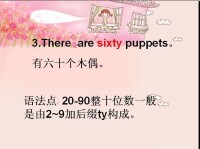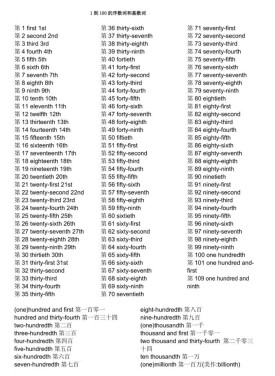數詞
數詞
數詞(Numeral),表示數量或順序的詞叫做數詞。英語的數詞可以作句子的主語、賓語、表語和定語。數詞分為兩大類,即基數詞和序數詞。基數詞表示數目,如:one,two,three,four……;序數詞表示順序,如:first,second,third,fourth……序數詞前一般要加the。
(1)通常與量片語合成數量短語,才能做句法成分,例如“十位長老”。數詞一般不直接跟名片語合,但是古漢語以“數·名”直接組合為常,現代也仍然保留某些古漢語說法,例如“一草一木”。
基數詞不能單獨做句法成分,只有在數學計算時或者文言格式中可單用,例如“一加一等於二”。
序數詞在特定情況下也可以直接修飾名詞,多數是組成專名,中間不用量詞。例如“第二車間”。
(2)數量短語通常用作定語或補語、狀語。例如“一片浮雲、看了一眼、一把拉住”。
(3)“倆”、“仨”是“兩個”、“三個”的合體數量詞,意義和功能相當於數量短語,後頭不能加量詞“個”。只用於口語,例如“倆人”、“哥兒倆”、“仨瓜倆棗”。
(4)倍數只能用來表示數目的增加,不能表示數目的減少;分數既可以表示數目的增加,也可以表示減少。
1)基數詞表示數量的多少

數詞舉例
3)基數詞一般是單數形式,但下列情況,常用複數:
a. 與of短語連用,表示概數,不能與具體數目連 用,如scores of people 指許多人;
b. 在一些表示"一排"或"一組"的片語里;
如:They arrived in twos and threes. 他們三三兩兩的到達了。
c. 表示"幾十歲"為dozens of ages;
d. 表示"年代",用 in the 數詞複數;
e. 在乘法運算的一種表示法里,如:3 x 5 = 15 Three fives is (are) fifteen.
| 1 | 2 | 3 | 4 | 5 | 6 | 7 | 8 | 9 | 10 |
| one | two | three | four | five | six | seven | eight | nine | ten |
| 11 | 12 | 13 | 14 | 15 | 16 | 17 | 18 | 19 |
| eleven | twelve | thirteen | fourteen | fifteen | sixteen | seventeen | eighteen | nineteen |
| 20 | 30 | 40 | 50 | 60 | 70 | 80 | 90 | 23 | 35 |
| twenty | thirty | forty | fifty | sixty | seventy | eighty | ninety | twenty-three | thirty-five |
| 100 | 1,000 | 1,000,000 | 1,000,000,000 | 101 |
| a hundred | a thousand | a million | a billion | one hundred and one |
位於another,all之後
如:Can you have another two cakes? 你還能吃2塊蛋糕嗎? The boy lost all the five pencils last week.這孩子上周把5枝鉛筆全丟了。
位於such和more之前
如:I can finish reading two such books in two days.兩天里我能讀完這樣的兩本書。Please give me one more apple to eat.請再給我一個蘋果吃。
可置於last,next,other之前或之後
如:His last two books are written in English.他的后兩本書是用英語寫的。
(1)基數詞 1-12 是獨立單詞,需逐個記憶。
基數詞 13-19是個位數詞的詞幹后加-teen 構成。其中 thirteen, fifteen, eighteen 變化不規則。
基數詞 20-90 是在個位數詞後面加 -ty 構成。其中 twenty, thirty, forty, fifty, eighty 變化不規則。
基數詞 21-99 是在十位數詞後面加上個位數詞合成,中間加上連字元 " - " 。
例如: 21 twenty-one,95 ninety-five
基數詞三位以上的數詞, 在百位和十位之間,一般要用連詞"and ",十萬位和萬位,億位和千萬位之間通常也要加and。例如: 132 one hundred and thirty-two,1340 one thousand three hundred and forty.
(2)英語中沒有萬,十萬,千萬,億這樣的單位數詞,ten thousand 十千,十千(1000×10)=一萬。故用阿拉伯數字書寫千以上的數目時,要由右向左每三位數間留一個空格或寫一個逗號。第一個前為thousand;第二個前為million;第三個前為thousand million(英)或billion(美)。每兩個空格間或兩個逗號間的三位數都被看作“十位數或百位數的千”或“十位數或百位數的百萬”。例如56 000 fifty-six thousand和600,000,000 six hundred million。
(3)dozen,score,hundred,thousand,million等數詞前面有基數詞或某些表示數量的形容詞時,不加-s。例如 a few hundred meters 幾百米 several million people 數百萬人 two thousand teachers 兩千位老師,但如表示“幾百”“幾千”“幾百萬”等籠統的數目時,則應用-s of構成短語。如:hundreds of books 幾百本書 thousands of workers 幾千個工人
(4)hundred、 thousand、 million作數詞時,不用複數,前面可以加上one, two, …等其它數詞。用作名詞時複數表示“成…上…”,後面必須要有of,前面可以加上some,many,several等詞。如:five hundred(五百), hundreds of(成百上千的), ten thousand(一萬), thousands of(成千上萬的), millions of(成百萬的).
找清規律很容易,十二以內詞名異;
十三數到十九去,后加-teen莫忘記。
二十、三十至九十,整十之後有-ty;
如果要說“幾十幾”,中間“-”號別丟棄,
hundred是“一百”,請你記住莫大意。
序數詞表示排列的順序
序數詞的縮寫形式為阿拉伯數字加序數詞的最後兩個字母。如: first---1st;second---2nd; third-3rd;
thirty-first---31st
一,二,三要全變;(one-first; two-second;three- third)
其餘都加th, th里有例外,8去t,(eight-eighth) 9去e(nine-ninth)
字母f代ve(five-fifth; twelve-twelfth);ty變成tie(twenty-twentieth)
若要變化幾十幾,只變個位就可以(twenty-one-twenty-first)
(1) 作定語。如:
There are only three boys in the class. 班上只有3名男生。
Ten people will come to the party. 十個人要來參加聚會。
(2) 作主語。如:
It is said that thirteen is an unlucky number. 據說13是個不吉利的數字。
Three of them will play football. 他們中有三人要去踢足球。
(3) 作賓語。如:
It is worth three hundred. 這件東西值300。
The city has a population of three million. 這個城市有三百萬人口。
(4) 作表語。如:
I am eighteen. 我18歲。
Two and two is four. 二加二等於四。
(5) 作同位語。如:
Are you two coming? 你們倆來嗎?
They ten will go abroad. 他們十個人將出國。
(1) 有時序數詞前面可加不定冠詞來表示“再一”,“又一”這樣的意思。如:
We'll have to do it again. 我們得重做一次。
Shall I ask him a third time? 還要再問他一次嗎?
When Nash sat down, a fourth man rose to speak.
納什坐下后,第四個人又起來發言。
(2) 序數詞的主要作用
作主語。如:
The first day of May is International Labour Day.五月一日是國際勞動節。
作表語。作表語時,序數詞前的定冠詞往往省去。如:
Lynd was second last year. 林德去 年是第二。
作賓語。如:
He was among the first to arrive. 他是首批到達的人員之一。
作定語。如:
May is the fifth month of the year. 五月是一年中的第五個月。
作同位語。如:
Who is the woman, the second in the second line? 在第二列第二個的那個婦女是誰?
但要注意:在很多情況下,我們可以用基數詞代替序數詞來表示順序。如:
the second part = Part two (第二部分)
the first chapter = Chapter one (第一章)
the fourth section = Section four (第四節)
1)倍數+形容詞/副詞比較級+than,用…times表示。
例如:The girl is ten times cleverer than her brother.
2)如果表示“是……兩倍數”,一般用twice。
例如:My room is twice as large as yours.
3)倍數+as+形容詞/副詞/名詞+as
例如:His apartment is three times as large as that of mine.
Americans eat twice as much protein as they actually need every day.
My aunt is as old age as I am. 我姑姑年齡比我大一倍。
4)倍數+名詞
例如:The volume of the Sun is about 1,300,000 times that of the earth.
太陽的體積約為地球的1300000倍。
5)動詞+倍數,用-fold或基數詞加times表示。
例如:The value of the stock has increased two-fold since we bought it.
Productivity is increased three fold. 生產效率提高了兩倍。
The pants have shortened two times since they were bought.
6)用double(翻一番),triple(三倍於),again等詞表示倍數。如:
This coat cost me as much again as the coat I have just bought.
The output of coal has doubled. 煤的產量增加了一倍。
小數點左邊的數通常按基數詞讀,若為三位以上的數,也可按編碼式讀法讀出,即將數字單個讀出;小數點右邊的數通常按編碼式讀法單個讀出。如:
6.86 six point eight six
14.15 fourteen point one five
345.456 three four five point four five six
或three hundred and forty-five point four five six
注意:小數中“0”的讀法
“0”在小數中通常讀作nought(英)或zero(美),也可讀作字母o。如:
0.08 (nought)point nought eight 或(zero)point zero eight
9.07 nine point o seven
百分數中的百分號%讀作percent。如:
6%讀作:six percent
0.6%讀作:(nought)point six percent
500%讀作:five hundred percent
12.34%讀作:twelve point three four percent
6+5=11 Six plus five is eleven 或 Six and five is eleven.
11-6=5 Eleven minus six is five. 或 Six from eleven is five.
4×5=20 Four multiplied by five is twenty.或 Four times five is twenty.
20÷4=5 Twenty divided by four is five. 或 Four into twenty goes five.
15:5=3 The ratio of fifteen to five is three.
2的2次方是4 2^2=4 Two squared is four.
2的3次方是8 2^3=8 Two cubed is eight.
2的4次方是16 2^4=16 The fourth power of two is sixteen.
X^(1/2)=Y The square root of X is Y.
X^(1/3)=Y The cubic root of X is Y.
a > b a is more than b.
a < b a is less than b.
a ≈ b a approximately equals to b.
a ≠ b a is not equal to b.
(1) 較小分數的一般讀寫方法。如:
1/3 one-third 2/3 two-thirds 3/5 three-fifths
(2) 較複雜分數的簡明讀寫方法。如
22/9 twenty-two over nine
a/b a over b 或 a divided by b 43/97 forty-three over ninety-seven
(3) 整數與分數之間須用and連接。如:
four and a half nine and two fifths
(4) 分數用作前置定語時,分母要用單數形式。注意下列寫法與讀法。如:
a one-third mile 1/3英里 a three-quarter majority 3/4的多數
年代用年份的阿拉伯數字加-’s或-s表示。如:
十七世紀二十年代寫作1620’s或1620s。
初期、中期、末期分別用early,mid-和late表示。如:
三十年代初期寫作the early thirties。
三十年代中期寫作the mid-thirties。
三十年代末期寫作the late thirties。
二十世紀五十年代初期寫作the early 1950’s;
中期寫作the mid-1950’s;
末期寫作the late 1950’s。
(1) 二十四小時計時法
二十四小時計時法通常採用“小時數:分鐘數”、“小時數.分鐘數”或“小時數分鐘數”的形式,如:
01:00 凌晨一點 (ou) one hour或one o'clock
01:20 凌晨一點二十分 (ou) one twenty或twenty past one
02:00 凌晨兩點 (ou)two hours或two o'clock
02:10 凌晨兩點十分 (ou) two ten或ten past two
3:05 凌晨三點五分 (ou) three(ou) five 或five past three
09:45 上午九點四十五 (ou) nine forty-five 或a quarter to ten
10:15 上午十點一刻 ten fifteen或a quarter past ten
12:00 中午十二點 twelve hours或midday或noon
12:45 中午十二點四十五 twelve forty-five或 a quarter to thirteen
13:00 下午一點 thirteen hours
15:30 下午三點半 fifteen thirty或half past fifteen
21:15 晚上九點一刻 twenty one fifteen
23:00 晚上十一點 twenty-three hours
23:05 晚上十一點零五分 twenty-three(ou)five
23:45 晚上十一點四十五分 twenty-three forty-five
00:00 零點 midnight或zero hour
00:15 零點十五分 midnight fifteen或zero hour fifteen
00:30 零點三十分 midnight thirty或zero hour thirty
(2) 十二小時計時法
十二小時計時法通常採用“小時數:分鐘數”或“小時數. 分鐘數”的形式,如:8:12或8.12。為了避免誤解,通常加上in the morning / a.m.(上午)或in the afternoon p.m.(下午)以示區別。a.m.是拉丁語ante meridiem的縮寫形式,讀作/'ei'em /,意思是“上午”, p.m.是拉丁語post meridiem的縮寫形式,意思是“下午;晚上”,讀作/'pi:'em/。若表示整點鐘,可加o'clock,也可不加。如:
8.00 a.m./8:00 a.m. 上午八點
讀作:eight a.m. 或 eight in the morning.
8.45 a.m./8:45 a.m. 上午八點四十五
讀作:eight forty-five a.m. 或 a quarter to nine in the morning.
2.00 p.m./2:00 p.m. 下午兩點
讀作:two(o'clock) p.m. 或 two (o'clock) in the afternoon.
3.30 p.m./3:30 p.m. 下午三點半
讀作:three thirty p/m. 或 half past three in the afternoon
5.15 p.m./5:15 p.m. 下午五點一刻
讀作:five fifteen p.m. 或 a quarter past five in the afternoon.
8.55 p.m./8:55 p.m. 晚上八點五十五
讀作:eight fifty-five at night 或 five to nine at night (at night指日落後到半夜零時。)
(3)、時間的表示:
主要看分鐘的大小:
1、大於30分鐘時,需要將小時加1,再用60減去分鐘數後用to連接。
2、小於或等於30分鐘時,直接在小時和分鐘間加上past就可以了。
1)年份通常用阿拉伯數字錶示,用基數詞讀。公元前用B.C.表示,公元用A.D.表示,讀 其字母音:A.D.一般用於公元1年到公元999年之間的年份。如:
公元前502年寫作502 B.C.
公元429年寫作429 A.D.
公元1000年寫作1000。
2)“日”用序數詞。如:
June 8, 1946或June eighth 1946:1946年6月8日
year two thousand:2000年
3)表示月、日既可以先寫“月”再寫“日”(英式),也可先寫“日”再寫“月”(美式)。如:
9月1日寫作September 1,讀作September the first;或1 September,讀作the first of
September。
4)表示“年”和“月”時,在“年”和“月”前用介詞in;表示具體日期時,在“日”前用介詞on. 如:
in 2003:在2003年
in July:在七月
on June 24, 1998:在1998年6月24日
(1) 英鎊的符號“£”放在數字前面,但單位詞“pound(s)”放在數字後面。
£50讀作: fifty pounds 50英鎊
(2) 便士可用“P”表示,單數為penny,複數為pence,放在數字後面。
1P讀作: one penny 1便士
5P讀作: five pence 5便士
£54.36讀作: five-four pounds thirty-six pence 54英鎊36便士
They imported nine thousand pounds worth(or value)of tea.
他們進口了價值九千英鎊的茶葉。
(3) 美元的符號“$”放在數字前面,但單詞“dollars”放在數字後面。
$2.25讀作: two dollars twenty-five cents 2美元25美分
$563讀作: five hundred sixty-three dollars 563美元
I got the coat for 90 cents. 我花了90美分買了這件衣服。
在借據、文書、帳單等重要文件中,錢數多以英語和阿拉伯數字兩種形式寫出。如:
I owe you (IOU) two thousand dollars($2,000). 今借到兩千美元($2,000)。
編碼式讀法指將數字逐一按基數詞讀出的方法。通常門牌號碼、房間號碼、電話號碼、郵政編碼、車牌號碼及其他專用編碼都採用編碼式讀法。凡採用編碼式讀法的數字都應在三位以上,兩位數字通常按基數詞讀,如:
Room 34 34號房間 讀作: room thirty-four
extension 2258 2258號分機 讀作: double two five eight
page 518 第518頁 讀作: page five one eight
大約表示
(1) about, approximately, around, more or less, roughly, some等詞 數詞,或數詞 more or less, or so, or thereabouts等詞。如:
about / some 1,000 books
2,000 seats more or less
approximately 86 miles
sixty or so pages / sixty pages or so / sixty pages or thereabouts
somewhere也可表示“大約”,如somewhere about 300 people。
(2) 基數詞或阿拉伯數字末尾 -ish。如:
I’ll come (at) tenish tomorrow morning. (十點左右)
She is 40ish. (四十歲左右)
(3) 十位數 -s。如:
He is in his teens.
She is in her forties.
多於表示
(1) above, more than, over等 數詞。如:
above 90 Yuan
students over 45
(2) 數詞 odd。如:
20-odd chairs
3.“少於……”、“不到……”表示法
almost, below, less than, under等 數詞。如:
almost ten years old
less than a minute
under two hours
1.a 序數詞(再一……,又一……)和the 序數詞(第……) I’ll see the movie a second time.(再看一次)
This is the second time I have seen the film. (第二次)
2. 具有誇張含義的成語中的數詞並不表示具體的數。如:
The glass broke into a hundred pieces.(摔得粉碎)
Once bitten, twice shy.(一次被咬,下次膽小)
A thousand thanks to you.(萬分感謝) 形容詞是指用來修飾名詞的詞。
形容詞最典型的位置是位於限定詞與名詞之間,在這種位置上的形容詞被稱為定語,如:
all those three old trees.
所有那三棵老樹。
形容詞的第二個重要位置是在be或其它系動詞之後,作主語補語用,如: The door is close. 門是關的。
作主語補語的形容詞還可以作賓主補語,如:He pushed the door open. 他把門推開了。
形容詞除了作定語、主語補語和賓語補語外,還可以作狀語,如:dark brown hair .深褐色的頭髮。
此外,某些形容詞在某些條件下具有名詞的句法作用,作主語或賓語。許多形容詞沒有形式特徵,但有些形容詞具有形式特徵,形容詞的典型詞尾包括:
-able / -ible, 如:comfortable, contemptible
-ish / -like, 如:childish, childlike
-ful / -less, 如:powerful, powerless
-ous, 如:delicious, anxious
-y, 如:pretty, dirty
數詞有基序數和序數詞兩類。基數詞表示數量的大小,如one, two, three, four等。序數詞表示序數,如first, second, third, fourth等。數詞與不定代詞、冠詞、指示代詞、形容詞性物主代詞等被稱作限定詞。
(1)第1至第19一般是在基數詞后加th,但變化特殊的有one—first, two—second, three—third, eight—eighth, nine—ninth, five—fifth, twelve—twelfth。
(2)逢十的twenty, thirty…ninety,分別改y為ieth。如twenty—twentieth, ninety—ninetieth。
(3)表示第幾十幾或第幾百幾十幾,只需將個位數改為序數詞。如56—fifty-six—fifty-sixth,635—six hundred and thirty-five—six hundred and thirty-fifth
(1)三位數的讀寫法:個位與十位之間用連字元“-”;百位與十位之間加and;十位為零時也要加and。如:
365讀作three hundred and six-five
605讀作six hundred and five
(2)大於三位數的讀寫法:從個位起每三位打一個撇號“’”,第一個撇號讀thousand,第二個撇號讀million,各撇號之間的數按三位及三位以下的數的讀法讀。如:
23, 589讀作twenty-three thousand five hundred and eighty-nine
6, 632, 900讀作six million six hundred and thirty-two thousand nine hundred
28, 000, 000讀作twenty-eight million
(1)序數詞前一般要加定冠詞the。如:
It’s the third time I’ve been here.這是我第三次到這裡來。
(2)表示在原有的基礎上增加,即“又一,再一”時,用不定冠詞。如:
Shall I ask her a third time? 我還要問她一次嗎?
(3)下列4種情況不用冠詞。
1. 序數詞前已有物主代詞或名詞所有格時,不能再用冠詞。如:
This is Tom’s second visit to China.這是湯姆第二次訪問中國。
2. 表示比賽或考試的名詞時,通常省略定冠詞。如:
He was (the) second in the English exam.在這次英語考試中他得了第二名。
3. 序數詞被用作副詞時不用冠詞。
I have to finish my homework first.我得先把作業完成好。
4. 在某些習語中不用冠詞。如at first起初, first of all首先, at first sight乍一看。
(1)作主語:The second was better.第二個好些。
(2)作表語:She was second in her class.她在班上是第二名。
(3)作賓語:I was among the first to arrive.我是第一批到的。
(4)作定語:There are fifty states in the US.美國有五十個州。
